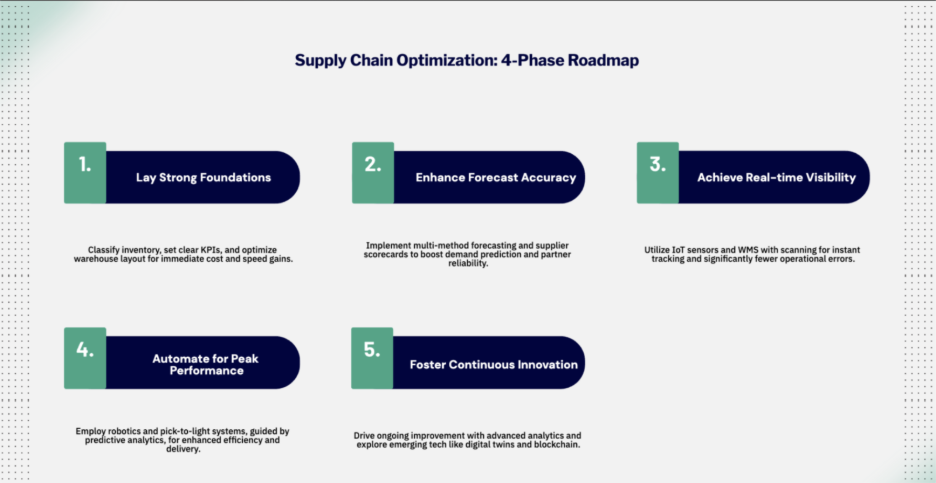



TL;DR
"A well-run organization turns over inventory faster than a badly run organization." - Warren Buffett
Here’s what happened when Weekends Only, a furniture retailer, decided to rethink its shipping strategy. Instead of always sending containers to Los Angeles, the team ran the numbers on shipping from China to New Orleans. With a bit of supply chain optimization software, they spotted 27% in cost savings and cut down on change-management risks.
That one call completely shifted their competitive position. Sounds obvious looking back, right? But at the time, the decision was nearly overlooked because the team was juggling more than 25 other priorities. Just another reminder of how small supply chain optimization decisions can create outsized results.
And while many companies focus on supply chain efficiency, a few retailers also lean on shipping insurance and extended warranties to protect profitability and margins because efficiency only goes further when it’s paired with customer trust.
Similarly, across the Atlantic, an Italian dairy company that took its sustainability commitments seriously partnered with SCM consultants to reduce its carbon footprint through logistics optimization. The result? Emissions were 11% lower, alongside reduced production costs and less waste.
And these aren’t isolated victories. There are countless real-world supply chain optimization examples like these. The numbers prove it: focused efforts cut costs by up to 25%, while comprehensive strategies often deliver 15–40% savings and 1–3% revenue growth.
So, is it really surprising that big-box retailers invest so much time and energy in supply chain efficiency?

The narrative around supply chain innovation has become dominated by artificial intelligence, but smart companies are discovering that the real magic happens when multiple technologies work together.
Take Terex, a giant global manufacturer that was drowning in manual yard management processes. They replaced outdated manual yard management with RFID tracking and yard management software. The solution provided daily inventory counts through business intelligence modules and eliminated the need for stickers, yard maps, and wallboards. No fancy AI algorithms, just smart application of existing technology that solved real problems.
Similarly, IoT sensors are delivering immediate, measurable results across the supply chain. Smart sensors enhance real-time data collection, providing insights into equipment performance, warehouse conditions, and product status. Enabling proactive maintenance and quicker response to issues, preventing costly downtime and reducing waste.
Data reflects that,
Quite likely you've heard of how blockchain technology is solving transparency and trust issues that have plagued supply chains for decades. Walmart's blockchain implementation for produce tracking reduced food safety investigation time from weeks to seconds.
The technology creates immutable records of every transaction, enabling end-to-end traceability that customers increasingly demand. It may sound complicated, but with the burst of service and software providers in this industry, it's become quite a standard and safe integration.
Automation and robotics too are reshaping warehouse operations with efficiency gains. Though this currently still is a solution that's easily available to most businesses.
Here's what's particularly interesting: Organizations with higher AI investment in supply chain operations report revenue growth 61% greater than their peers. But the companies achieving these results aren't just throwing AI at problems, they're combining it strategically with other technologies to create comprehensive solutions.
The story of supply chain optimization isn’t limited to global giants, it’s equally powerful for mid-sized and even small businesses.
In fact, NIST suggests through, its Supply Chain Optimization and Intelligence Network (SCOIN) that better visibility and collaboration tools can help manufacturers strengthen their supply chains by improving existing networks and filling critical gaps.
Consider AGCO, an agricultural equipment manufacturer that was struggling with supply chain complexity across five separate brands. The company's sourcing challenges and inbound logistics were managed by teams in various countries, each with different levels of supply chain management maturity and using different tools. Following a benchmarking exercise, AGCO implemented a globally integrated transport management system combined with 3PL partnerships. The results transformed their operations across multiple regions.
Deere & Company faced similar challenges with inventory management and delivery performance. The company undertook a supply chain network-redesign program, commissioning intermediate "merge centers" and optimizing cross-dock terminal locations.
They consolidated shipments, used break-bulk terminals during seasonal peaks, and increased third-party logistics partnerships. The results: inventory decrease of $1 billion, customer delivery lead times reduced from ten days to five or less, and annual transportation cost savings of around 5%.
Even smaller companies are finding success. Clif Bar, an organic food company popular for their health bars, developed an innovative approach to supply chain sustainability. The company hires independent energy experts to provide consulting to suppliers at Clif Bar's expense.
These experts help suppliers assess electricity usage and develop methods for installing renewable energy or purchasing green power. This creative approach reduces costs throughout their supply chain while building stronger supplier relationships.
Predictive analytics enables proactive management with measurable outcomes. Companies implementing advanced demand planning report 15% reductions in stock-outs with 20% improvements in inventory turnover, while predictive maintenance delivers 10% improvements in Overall Equipment Effectiveness.
The pattern across these success stories is clear: optimization isn't about having the biggest budget or the most sophisticated technology. It's about systematically identifying inefficiencies and applying the right solutions to address them.

But it's not just about anecdotes, there's a lot of data, and in recent times- several specialized SCM consultancies as well which are helping businesses move much more flexibly and swiftly. While the individual processes vary based on the specific consultancy and business type, here's what the typical process looks like-
It always starts with inventory classification using ABC analysis, i.e.- classifying inventory by value and demand variability to enable segmented forecasting that reduces overall inventory carrying costs by 15-25%. When paired with smart warranty systems through inventory and warranty integration, the dots connect even further, turning basic classification into customer and margin gains.
This simple step provides immediate insights and sets the stage for more sophisticated supply chain optimization techniques.
Next, we establish key performance metrics including inventory turnover, order accuracy, delivery performance, and customer satisfaction. Evidence-based decisions allow management to optimize routes, allocate resources effectively, and streamline various logistic processes.
Followed by optimizing your warehouse layout by placing high-velocity items near picking stations and grouping frequently ordered items together. Strategic warehouse layout design can reduce picking time by up to 55%. Yes, you read that right. Doesn't sound as obvious, but that's how reality plays out.
Deploying demand forecasting using multiple methods that combine quantitative analysis with qualitative insights. These multi-method approaches deliver 10-30% improvements in forecast accuracy.
Developing supplier scorecards weighing quality (30%), delivery (25%), cost (20%), service (15%), and innovation (10%). This enables objective performance management and creates a framework for continuous improvement.
You should also consider warehouse management system implementation. WMS implementation with barcode scanning and real-time tracking has been shown to deliver 65% reductions in human error along with 92% reductions in shipping time.

Evaluate IoT sensor deployment for real-time tracking and monitoring. Start with high-value or time-sensitive products where visibility provides the greatest benefit.
Consider automation technologies based on your volume and complexity. Pick-to-light systems cut errors by 60-70%, while automated systems reduce delivery errors by 40-50%.
Implementing advanced analytics for demand sensing and predictive maintenance also helps. Reinforcement learning algorithms can calculate optimal inventory levels for products while adjusting to market demand changes, optimizing inventory levels and saving costs.
Establishing continuous improvement processes with regular performance reviews and optimization opportunities help. Companies that leverage advanced analytics gain a significant edge in adapting to market changes and optimizing processes.
Lastly consider exploring emerging technologies like digital twins and blockchain based on your specific needs and industry requirements. Digital twin technology enables scenario planning, network optimization, and risk management that is impossible to test in real operations.

Supply chain optimization isn’t optional anymore; it’s table stakes for competitive survival. The companies implementing these strategies today are building sustainable advantages that compound over time. Some levers, like demand forecasting, warehouse optimization, smart inventory management, and routing strategies, are potential quick wins that can deliver EBITDA results within the first year.
As the market shifts, your supply chain will either become your competitive edge or your biggest liability. Every day without optimization is a day competitors gain ground through better efficiency, lower costs, and superior customer experiences.
The transformation doesn’t demand massive investments or complex enterprise systems. What it does require is systematic thinking, disciplined execution, and a willingness to challenge existing processes. Starting with the fundamentals, tracking the right KPIs, improving sourcing decisions, and using predictive analytics in supply chain planning, creates momentum. Those early wins can then fund larger initiatives.
And remember, comprehensive supply chain optimization includes product protection. Pairing operational improvements with warranties and post-purchase safeguards builds customer confidence and reduces costly return-related disruptions.
"In business, the competition will bite you if you keep running; if you stand still, they will swallow you." - William S. Knudsen Jr.